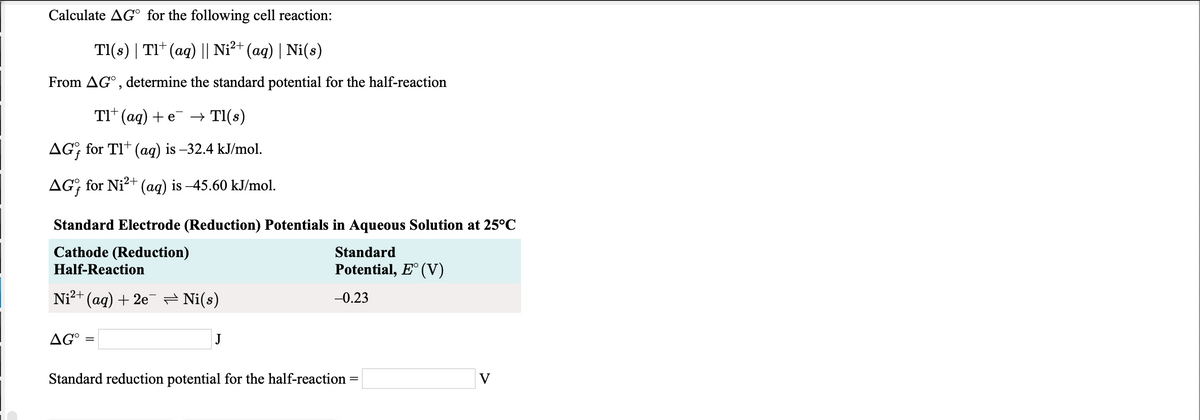Calculate AG° for the following cell reaction: TI(s) | TI* (aq) || Ni²* (aq) | Ni(s) From AG°, determine the standard potential for the half-reaction TI* (aq) + e¯ → TI(s) AG; for TI* (aq) is –32.4 kJ/mol. AG, for Ni?+ (aq) is -45.60 kJ/mol. Standard Electrode (Reduction) Potentials in Aqueous Solution at 25°C Cathode (Reduction) Half-Reaction Standard Potential, E° (V) Ni?+ (aq) + 2e¯ Ni(s) -0.23 AG J Standard reduction potential for the half-reaction = V
Calculate AG° for the following cell reaction: TI(s) | TI* (aq) || Ni²* (aq) | Ni(s) From AG°, determine the standard potential for the half-reaction TI* (aq) + e¯ → TI(s) AG; for TI* (aq) is –32.4 kJ/mol. AG, for Ni?+ (aq) is -45.60 kJ/mol. Standard Electrode (Reduction) Potentials in Aqueous Solution at 25°C Cathode (Reduction) Half-Reaction Standard Potential, E° (V) Ni?+ (aq) + 2e¯ Ni(s) -0.23 AG J Standard reduction potential for the half-reaction = V
General Chemistry - Standalone book (MindTap Course List)
11th Edition
ISBN:9781305580343
Author:Steven D. Gammon, Ebbing, Darrell Ebbing, Steven D., Darrell; Gammon, Darrell Ebbing; Steven D. Gammon, Darrell D.; Gammon, Ebbing; Steven D. Gammon; Darrell
Publisher:Steven D. Gammon, Ebbing, Darrell Ebbing, Steven D., Darrell; Gammon, Darrell Ebbing; Steven D. Gammon, Darrell D.; Gammon, Ebbing; Steven D. Gammon; Darrell
Chapter19: Electrochemistry
Section: Chapter Questions
Problem 19.128QP: a Calculate G for the following cell reaction: Tl(s)Tl+(aq)Pb2+(aq)Pb(s) The Gf for Tl+(aq) is 32.4...
Related questions
Question

Transcribed Image Text:Calculate AG° for the following cell reaction:
TI(s) | TI* (ag) || Ni²+ (aq) | Ni(s)
From AG° , determine the standard potential for the half-reaction
TI* (aq) + e
→ TI(s)
AG; for TI* (aq) is –32.4 kJ/mol.
AG; for Ni?+ (ag) is –45.60 kJ/mol.
Standard Electrode (Reduction) Potentials in Aqueous Solution at 25°C
Cathode (Reduction)
Half-Reaction
Standard
Potential, E° (V)
Ni?+ (aq) + 2e = Ni(s)
-0.23
AG°
Standard reduction potential for the half-reaction
V
Expert Solution
This question has been solved!
Explore an expertly crafted, step-by-step solution for a thorough understanding of key concepts.
Step by step
Solved in 4 steps

Knowledge Booster
Learn more about
Need a deep-dive on the concept behind this application? Look no further. Learn more about this topic, chemistry and related others by exploring similar questions and additional content below.Recommended textbooks for you

General Chemistry - Standalone book (MindTap Cour…
Chemistry
ISBN:
9781305580343
Author:
Steven D. Gammon, Ebbing, Darrell Ebbing, Steven D., Darrell; Gammon, Darrell Ebbing; Steven D. Gammon, Darrell D.; Gammon, Ebbing; Steven D. Gammon; Darrell
Publisher:
Cengage Learning

Chemistry: Principles and Practice
Chemistry
ISBN:
9780534420123
Author:
Daniel L. Reger, Scott R. Goode, David W. Ball, Edward Mercer
Publisher:
Cengage Learning

Chemistry & Chemical Reactivity
Chemistry
ISBN:
9781337399074
Author:
John C. Kotz, Paul M. Treichel, John Townsend, David Treichel
Publisher:
Cengage Learning

General Chemistry - Standalone book (MindTap Cour…
Chemistry
ISBN:
9781305580343
Author:
Steven D. Gammon, Ebbing, Darrell Ebbing, Steven D., Darrell; Gammon, Darrell Ebbing; Steven D. Gammon, Darrell D.; Gammon, Ebbing; Steven D. Gammon; Darrell
Publisher:
Cengage Learning

Chemistry: Principles and Practice
Chemistry
ISBN:
9780534420123
Author:
Daniel L. Reger, Scott R. Goode, David W. Ball, Edward Mercer
Publisher:
Cengage Learning

Chemistry & Chemical Reactivity
Chemistry
ISBN:
9781337399074
Author:
John C. Kotz, Paul M. Treichel, John Townsend, David Treichel
Publisher:
Cengage Learning

Chemistry & Chemical Reactivity
Chemistry
ISBN:
9781133949640
Author:
John C. Kotz, Paul M. Treichel, John Townsend, David Treichel
Publisher:
Cengage Learning

Principles of Modern Chemistry
Chemistry
ISBN:
9781305079113
Author:
David W. Oxtoby, H. Pat Gillis, Laurie J. Butler
Publisher:
Cengage Learning

Chemistry: The Molecular Science
Chemistry
ISBN:
9781285199047
Author:
John W. Moore, Conrad L. Stanitski
Publisher:
Cengage Learning